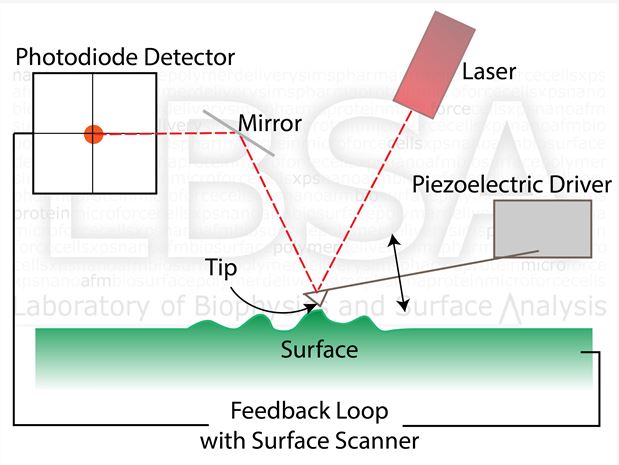What is AFM?
Overview
AFM is a scanning probe technique used for characterising surfaces at the nanoscale.
An AFM probe consists of a sharp tip loaded on a stiff microcantilever. When the tip is brought into close proximity with a surface, the interactions between the tip and the surface can be detected by measuring the deflection of the cantilever. The primary method of detection is via optical lever, a method involving a laser deflected off the cantilever and onto a four-quadrant photodiode. Because AFM does not rely on refraction of electromagnetic waves (as optical and electron microscopy do), the environment is not limited to vacuum. In fact, the AFM can be operated under a range of conditions and temperatures.

A basic schematic outlining principle of AFM, courtesy of R Creasey
Very sensitive measurements of force between the tip and the surface can be measured using AFM. Surface properties such as adhesion, stiffness, and deformation can be obtained by observing the cantilever deflection as the tip is brought into contact with the surface. By altering the chemical and physical properties of the probe, different properties can be investigated on the same sample.
Sample considerations
As AFM interacts with the surface in order to take measurements, not all samples will be appropriate for measurement. It's important that a sample is properly immobilised and relatively flat (within several micrometers). With the right preparations, many samples can be measured by AFM in some way.
Our publications and further reading
There is a range of literature available for those wanting to learn more about AFM, from different operating modes to engineering specifications. A select few have been provided below if you want to learn more:
- A comprehensive introduction to AFM, including a short history and links to product websites
- For the more visual learners, a site using animations to describe the basic modes of AFM
- Information including seminars and a comprehensive bibliography provided by on AFM manufacturer with a focus on life sciences applications
- G. Binning, C. Quate, C. Gerber, Atomic Force Microscopy, Phys. Rev. Lett. 56 (1986)
- V.J. Morris, A.R. Kirby, A.P. Gunning Atomic Force Microscopy for Biologists, 2nd edition, Imperial College Press, 2009
Back to our Expertise and Equipment